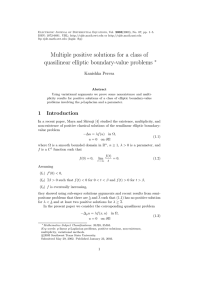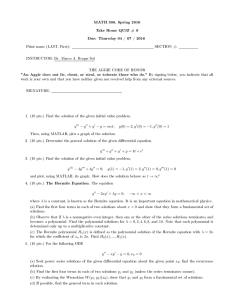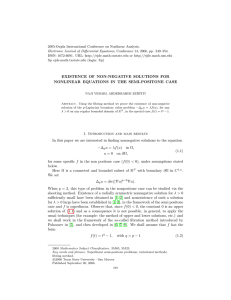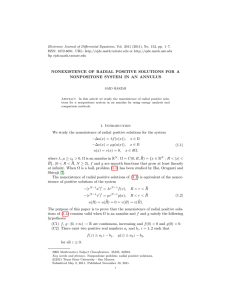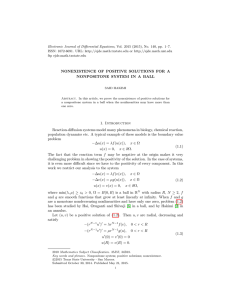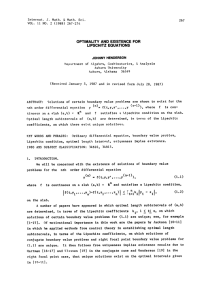Seventh Mississippi State - UAB Conference on Differential Equations and... Simulations, Electronic Journal of Differential Equations, Conf. 17 (2009), pp.123–131.
advertisement
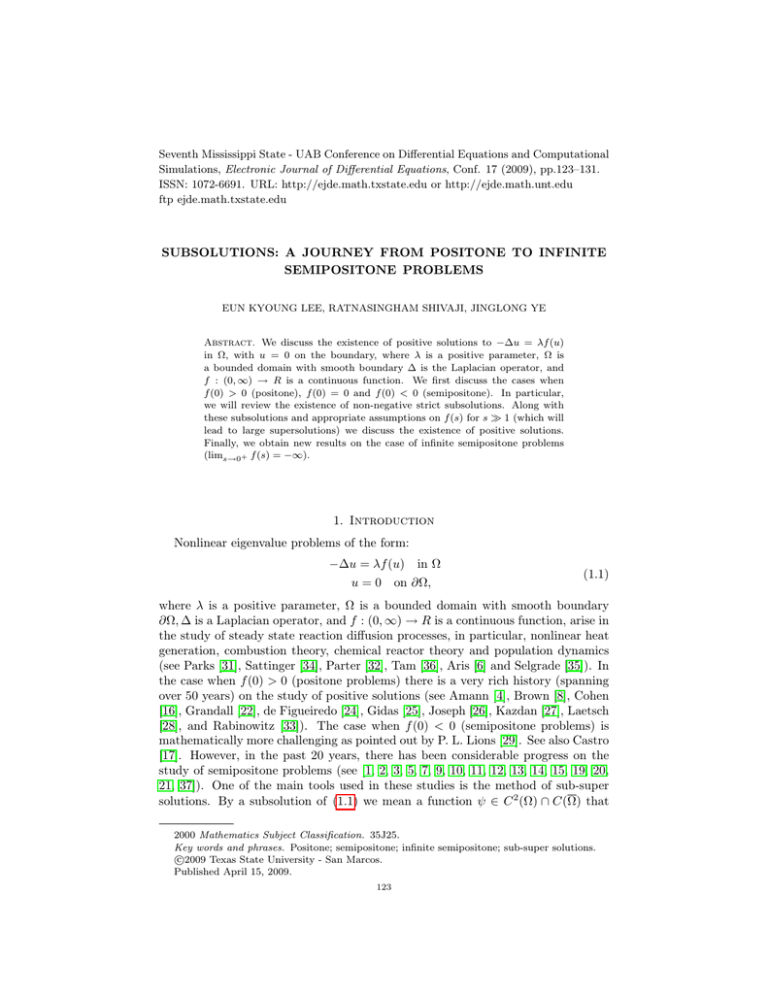
Seventh Mississippi State - UAB Conference on Differential Equations and Computational
Simulations, Electronic Journal of Differential Equations, Conf. 17 (2009), pp.123–131.
ISSN: 1072-6691. URL: http://ejde.math.txstate.edu or http://ejde.math.unt.edu
ftp ejde.math.txstate.edu
SUBSOLUTIONS: A JOURNEY FROM POSITONE TO INFINITE
SEMIPOSITONE PROBLEMS
EUN KYOUNG LEE, RATNASINGHAM SHIVAJI, JINGLONG YE
Abstract. We discuss the existence of positive solutions to −∆u = λf (u)
in Ω, with u = 0 on the boundary, where λ is a positive parameter, Ω is
a bounded domain with smooth boundary ∆ is the Laplacian operator, and
f : (0, ∞) → R is a continuous function. We first discuss the cases when
f (0) > 0 (positone), f (0) = 0 and f (0) < 0 (semipositone). In particular,
we will review the existence of non-negative strict subsolutions. Along with
these subsolutions and appropriate assumptions on f (s) for s 1 (which will
lead to large supersolutions) we discuss the existence of positive solutions.
Finally, we obtain new results on the case of infinite semipositone problems
(lims→0+ f (s) = −∞).
1. Introduction
Nonlinear eigenvalue problems of the form:
−∆u = λf (u)
u=0
in Ω
on ∂Ω,
(1.1)
where λ is a positive parameter, Ω is a bounded domain with smooth boundary
∂Ω, ∆ is a Laplacian operator, and f : (0, ∞) → R is a continuous function, arise in
the study of steady state reaction diffusion processes, in particular, nonlinear heat
generation, combustion theory, chemical reactor theory and population dynamics
(see Parks [31], Sattinger [34], Parter [32], Tam [36], Aris [6] and Selgrade [35]). In
the case when f (0) > 0 (positone problems) there is a very rich history (spanning
over 50 years) on the study of positive solutions (see Amann [4], Brown [8], Cohen
[16], Grandall [22], de Figueiredo [24], Gidas [25], Joseph [26], Kazdan [27], Laetsch
[28], and Rabinowitz [33]). The case when f (0) < 0 (semipositone problems) is
mathematically more challenging as pointed out by P. L. Lions [29]. See also Castro
[17]. However, in the past 20 years, there has been considerable progress on the
study of semipositone problems (see [1, 2, 3, 5, 7, 9, 10, 11, 12, 13, 14, 15, 19, 20,
21, 37]). One of the main tools used in these studies is the method of sub-super
solutions. By a subsolution of (1.1) we mean a function ψ ∈ C 2 (Ω) ∩ C(Ω) that
2000 Mathematics Subject Classification. 35J25.
Key words and phrases. Positone; semipositone; infinite semipositone; sub-super solutions.
c
2009
Texas State University - San Marcos.
Published April 15, 2009.
123
124
E. K. LEE, R. SHIVAJI, J. YE
EJDE/CONF/17
satisfies
−∆ψ ≤ λf (ψ)
ψ≤0
in Ω
on ∂Ω,
and by a supersolution of (1.1) we mean a function Z ∈ C 2 (Ω) ∩ C(Ω) that satisfies
−∆Z ≥ λf (Z)
Z≥0
in Ω
on ∂Ω.
Then it is well known (see Amman [4]) that if there exists a subsolution ψ and
a supersolution Z such that ψ ≤ Z in Ω then (1.1) has a solution u such that
ψ ≤ u ≤ Z. In applying this method to obtain positive solutions, it is essential that
we are able to construct non-negative strict subsolutions. By a strict subsolution we
mean a subsolution that is not a solution. In the case when f (0) > 0, it is trivial to
see that ψ = 0 is a strict subsolution for every λ > 0. More on positone problems
will be discussed in Section 2. But the real challenge occurs in the case when
f (0) < 0 (semipositone problems). Here our test functions for positive subsolutions
must come from positive functions ψ such that −∆ψ < 0 near ∂Ω while −∆ψ > 0
in a large part of the interior of Ω. We will discuss more on semipositone problems
in Section 3. The case when f (0) = 0 does cause considerable problems in the
construction of positive subsolutions, specially in the case when we have no other
information at the origin. We will address this later in Section 4. Finally in Section
5, we will establish new results for the case when lims→0+ f (s) = −∞ (infinite
semipositone problems). We note that once strict non-negative subsolutions ψ are
constructed, with appropriate assumptions on f (s) for s 1 one can obtain large
positive supsolutions Z such that Z ≥ ψ on Ω, hence establishing positive solutions
to (1.1).
2. f (0) > 0: Positone Problems
In this section, we consider the problem (1.1) under the following assumption
(F0) f (0) > 0.
(F1) lims→∞ f (s)
s = 0.
We have the following result
Theorem 2.1. Assume (F0), (F1). Then (1.1) has a positive solution for all λ > 0.
Proof. It is clear that ψ = 0 is a strict subsolution since f (0) > 0. Let fe(s) :=
e
maxt∈[0,s] f (t). Then f (s) ≤ fe(s), fe is nondecreasing and lims→∞ f (s)
s = 0. Hence
we can choose m(λ) 1 such that
1
fe(m(λ)kek∞ )
≥
kek∞ λ
m(λ)kek∞
where e is the solution of −∆e = 1 in Ω, e = 0 on ∂Ω. Let Z := m(λ)e. Then
−∆Z = m(λ) ≥ λfe(m(λ)kek∞ ) ≥ λfe(m(λ)e) ≥ λf (m(λ)e).
Thus Z is a supersolution. Hence (1.1) has a positive solution.
EJDE-2009/CONF/17
POSITONE TO INFINITE SEMIPOSITONE PROBLEMS
125
3. f (0) < 0: Semipositone Problems
In this section, we discuss two results for the problem (P ). First, we assume
that
(F2) There exists K0 > 0 such that f (s) ≥ −K0 for all s > 0.
(F3) lims→∞ f (s) = ∞.
Note that (F2) includes the case f (0) < 0.
Theorem 3.1. Assume (F1), (F2), (F3). Then (1.1) has a positive solution for
λ 1.
Proof. Let λ1 > 0 be the first eigenvalue of the operator −∆ with Dirichlet boundary condition and φ be the corresponding eigenfunction satisfying φ > 0 in Ω and
∂φ
∂ν < 0 on ∂Ω, where ν is outward normal vector on ∂Ω and kφk∞ = 1. Note that
λ1 and φ satisfy:
−∆φ = λ1 φ in Ω
φ=0
on ∂Ω.
Let δ > 0, µ > 0, m > 0 be such that |∇φ|2 − λ1 φ2 ≥ m in Ωδ and µ ≤ φ ≤ 1 in
6 0 on ∂Ω.
Ω \ Ωδ where Ωδ := {x ∈ Ω : d(x, ∂Ω) ≤ δ}. This is possible since |∇φ| =
0λ 2
Let ψ := K2m
φ . Then
K0 λ
∇ψ =
φ∇φ
m
and
K0 λ
K0 λ
{φ∆φ + |∇φ|2 } = −
{|∇φ|2 − λ1 φ2 }
−∆ψ = −div(∇ψ) = −
m
m
Then in Ωδ ,
−∆ψ ≤ −K0 λ ≤ λf (ψ).
(3.1)
From (F3), we know that for λ 1
K0 λ 2
K0 λ 1
≤ f(
µ ).
m
2m
Thus in Ω \ Ωδ ,
K0 λλ1
K0 λ 2
≤ λf (
φ ) = λf (ψ).
m
2m
Combining (3.1) and (3.2), if λ 1 we see that
−∆ψ ≤
−∆ψ ≤ λf (ψ)
(3.2)
in Ω.
Thus ψ is a positive subsolution of (1.1). Next constructing a supersolution Z as
in the proof of Theorem 2.1, we can also choose m(λ) large enough so that Z ≥ ψ
∂e
in Ω. This is possible since e > 0 in Ω and ∂ν
< 0 on ∂Ω, where ν is outward
normal vector on ∂Ω. Thus we know that (1.1) has a positive solution u ∈ [ψ, Z]
for λ 1.
We next discuss a semipositone problem where f (u) < 0 for u 1. (Hence in
this case (F 3) will not be satisfied.) In particular, we recall the example
−∆u = au − bu2 − c in Ω
u=0
on ∂Ω,
(3.3)
126
E. K. LEE, R. SHIVAJI, J. YE
EJDE/CONF/17
studied in [30]. This equation arises in the study of population dynamics of one
species with u representing the concentration of the species and c representing
the rate of harvesting. To get a positive subsolution, in [30] the authors use the
anti-maximum principle by Clement and Peletier [18], and establish the following
result:
Theorem 3.2. Suppose that a > λ1 and b > 0. Then there exists c1 = c1 (a, b)
such that for 0 < c < c1 , (3.3) has a positive solution.
Proof. Consider the boundary-value problem
−∆z − λz = −1
z=0
in Ω
on ∂Ω.
(3.4)
By the anti-maximum principle in [18], there exist a δ1 = δ1 (Ω) > 0 such that if
λ
λ ∈ (λ1 , λ1 + δ1 ) then (3.4) has a solution z = zλ which is positive in Ω and ∂z
∂ν < 0
on ∂Ω. Fix λ∗ ∈ (λ1 , min{a, λ1 + δ1 }). Let zλ∗ be the solution of (3.4) when λ = λ∗
and α := kzλ∗ k∞ . Define ψ = Kczλ∗ , where K ≥ 1 is to be determined later. We
will choose K ≥ 1 and c > 0 properly so that ψ is a subsolution. We know
−∆ψ = Kc(−∆zλ∗ ) = Kc(λ∗ zλ∗ ) − Kc.
Thus if we prove
(a − λ∗ )Kzλ∗ − bc(Kzλ∗ )2 + K − 1 ≥ 0,
(3.5)
then
−∆ψ = Kc(λ∗ zλ∗ ) − Kc ≤ a(Kczλ∗ ) − b(Kczλ∗ )2 − c.
Thus ψ = Kczλ∗ can be a subsolution of (3.3). To show (3.5), define H(y) := (a −
λ∗ )y−bcy 2 +(K −1). If H(y) ≥ 0 for all y ∈ [0, Kα], then (3.5) is true. Since a > λ∗ ,
if K ≥ 1, then it suffice to show that H(Kα) = (a−λ∗ )Kα−bc(Kα)2 +(K −1) ≥ 0,
which is equivalent to
(a − λ∗ )Kα + (K − 1)
c≤
b(Kα)2
Thus if we define
(a − λ∗ )Kα + (K − 1)
,
b(Kα)2
K≥1
c1 = c1 (a, b) := sup
then we know that when 0 < c < c1 , there exist K̃ ≥ 1 such that ψ = K̃czλ∗ is a
subsolution. It is obvious that Z = M where M is sufficiently large constant is a
supersolution of (3.3) with Z ≥ ψ. Thus Theorem 3.2 is proven.
4. f (0) = 0
In this section, we consider the problem (1.1) for the case f (0) = 0. Since (F 2)
includes the case f (0) = 0, we’ve already discussed this case in Theorem 3.1. We
now discuss a more precise result under the additional assumption
(F4) f (0) = 0 and f 0 (0) > 0.
Theorem 4.1. Assume (F1), (F4). Then (1.1) has a positive solution for λ >
λ1 /f 0 (0).
EJDE-2009/CONF/17
POSITONE TO INFINITE SEMIPOSITONE PROBLEMS
127
Proof. Since f 0 (0) > λ1 /λ we know that there exist m = m(λ) > 0 such that
λ1
s for all s ∈ (0, m).
λ
Let ψ := mφ where φ is as defined in the proof of Theorem 3.1. Then
f (s) >
(4.1)
−∆ψ = λ1 mφ ≤ λf (mφ) = λf (ψ).
Thus ψ is a positive subsolution of (1.1). By the same argument as in the proof of
Theorem 3.1, we can find a supersolution Z of (1.1) with Z ≥ ψ. Thus we know
1
that (1.1) has a positive solution u ∈ [ψ, Z] for λ > f λ0 (0)
.
For the case f (0) = 0, we can also study (1.1) when f does not satisfy (F1) but
satisfies
(F5) There exists r0 > 0 such that f (s) > 0 for s ∈ (0, r0 ) and f (r0 ) = 0.
Theorem 4.2. Assume (F5). Then (1.1) has a positive solution for λ 1.
Proof. Fix σ ∈ (0, r0 ) and let ψ := σ2 φ2 where φ is as defined in the proof of
Theorem 3.1. Then
−∆ψ = −σ{|∇φ|2 − λ1 φ2 }.
Let δ > 0, µ > 0, m > 0 and Ωδ be as before (see the proof of Theorem 3.1). We
can choose λ 1 such that
σλ1 < λ
min
f (s).
min
f (s) ≤ λf (ψ).
2
s∈[ σ
2 µ ,σ]
Thus in Ω \ Ωδ for λ 1,
−∆ψ ≤ σλ1 < λ
2
s∈[ σ
2 µ ,σ]
(4.2)
On the other hand, in Ωδ ,
−∆ψ < −σm ≤ λf (ψ),
(4.3)
since λf (ψ) ≥ 0. Combining (4.2) and (4.3), if λ 1 we see that ψ is a positive
subsolution of (1.1). Next, it is easy to check that constant function Z := r0 is a
supersolution of (1.1) with Z ≥ ψ. Hence for λ 1, (1.1) has a positive solution
and Theorem 4.2 is proven.
5. lims→0+ f (s) = −∞: Infinite Semipositone Problems
We discuss the existence of positive solutions to the following infinite semipositone problem:
g(u)
−∆u = λ α
in Ω
(5.1)
u
u=0
on ∂Ω,
where λ > 0, α ∈ (0, 1), g(0) < 0 and g is continuous. We introduce the following
hypotheses:
(G1) There exists γ > 0 and B > 0 such that α ≤ γ < α + 1 and g(s) ≤ Bsγ for
s ≥ 0.
(G2) There exists β > 0 and A > 0 such that g(s) ≥ Asβ for s 1.
We establish the following result.
Theorem 5.1. Assume (G1), (G2). Then (5.1) has a positive solution for λ 1.
128
E. K. LEE, R. SHIVAJI, J. YE
EJDE/CONF/17
We prove our result by finding sub-super solutions to our singular equation. By
a subsolution of (5.1) we mean a function ψ : Ω → R such that ψ ∈ C 2 (Ω) ∩ C(Ω)
and satisfies:
g(ψ)
in Ω
−∆ψ ≤ λ α
ψ
ψ > 0 in Ω
ψ = 0 on ∂Ω
and by a supersolution of (5.1) we mean a function Z : Ω → R such that Z ∈
C 2 (Ω) ∩ C(Ω) and satisfies:
g(Z)
in Ω
Zα
Z > 0 in Ω
−∆Z ≥ λ
Z=0
on ∂Ω.
Then we have the following Lemma.
Lemma 5.2 ([23]). If there exist a subsolution ψ and a supersolution Z of (5.1)
such that ψ ≤ Z on Ω, then (5.1) has at least one solution u ∈ C 2 (Ω) ∩ C(Ω)
satisfying ψ ≤ u ≤ Z on Ω.
Proof. Let φ be the eigenfunction as defined in the proof of Theorem 3.1. Let
2
1
1
, 1+α−β
). Then
ψ := λr φ 1+α , r ∈ ( 1+α
∇ψ = λr (
1−α
2
)φ 1+α ∇φ
1+α
and
1−α
2α
2
1 − α − 1+α
){φ 1+α ∆φ +
φ
|∇φ|2 }
1+α
1+α
2
1
1 − α
= λr (
)
{λ1 φ2 −
|∇φ|2 }.
2
1 + α (φ 1+α )α
1+α
−∆ψ = −λr (
Let δ > 0, µ > 0, m > 0 be such that
2
1−α
(
){(
)|∇φ|2 − λ1 φ2 } ≥ m in Ωδ ,
1+α
1+α
and φ ∈ [µ, 1] in Ω \ Ωδ , where Ωδ := {x ∈ Ω : d(x, ∂Ω) ≤ δ}. Then in Ωδ , if λ 1
then
2
1−α
λg(0)
(
){λ1 φ2 − (
)|∇φ|2 } ≤ −m ≤ r rα = λ[1−r−rα] g(0)
1+α
1+α
λ λ
since g(0) < 0 and 1 − r − rα < 0. Hence in Ωδ , if λ 1 then
2
2
1
1 − α
g(λr φ 1+α )
−∆ψ = λ (
)
{λ1 φ2 −
|∇φ|2 } ≤ λ
.
2
2
1 + α (φ 1+α )α
1+α
(λr φ 1+α )α
r
Next in Ω \ Ωδ , since φ ≥ µ, from (G2),
2
2
g(λr φ 1+α ) ≥ A(λr φ 1+α )β ,
for λ 1. Also since 0 < µ ≤ φ < 1 and 1 + r(β − α) − r > 0,
2
(
2
2
2λ1
A(λr φ 1+α )β
)[λr φ 1+α ] ≤ λA(λr φ 1+α )β−α = λ
,
2
1+α
(λr φ 1+α )α
(5.2)
EJDE-2009/CONF/17
POSITONE TO INFINITE SEMIPOSITONE PROBLEMS
129
for λ 1. Hence in Ω \ Ωδ , for λ 1,
2
2
2
2
g(λr φ 1+α )
A(λr φ 1+α )β
−∆ψ ≤ λ (
≤λ
.
)λ1 φ 1+α ≤ λ
2
2
1+α
(λr φ 1+α )α
(λr φ 1+α )α
r
(5.3)
Combining (5.2) and (5.3), we see that
−∆ψ ≤ λ
g(ψ)
ψα
in Ω
for λ 1. Thus ψ is a positive subsolution.
Now we construct a supersolution Z ≥ ψ. Since 1 + α − γ > 0 and γ − α ≥ 0,
we can choose m(λ) 1 such that
m(λ)1+α−γ ≥ λBeγ−α
where e is the unique positive solution of −∆e = 1 in Ω, e = 0 on ∂Ω. Hence for
m(λ) 1
λB(m(λ)e)γ
m(λ) ≥
.
(m(λ)e)α
Let Z := m(λ)e. Then by (G1) we have
−∆Z = m(λ) ≥
λg(m(λ)e)
.
(m(λ)e)α
Thus Z is a supersolution. Further m(λ) can be chosen large enough so that Z ≥ ψ
∂e
< 0 on ∂Ω, where ν is outward
on Ω. This is possible since e > 0 in Ω and ∂ν
normal vector on ∂Ω. Hence for λ 1, (5.1) has a positive solution and the proof
is complete.
References
[1] A. Ambrosetti, D. Arcoya and B. Biffoni, Positive solutions for some semipositone problems
via bifurcation theory, Differential Integral Equations, 7(3) (1994), 655-663.
[2] I. Ali, A. Castro and R. Shivaji, Uniqueness and stability of nonnegative solutions for semipositone problems in a ball, Proc. Amer. Math. Soc. 7 (1993), 775-782.
[3] V. Anuradha, D. Hai and R. Shivaji, Existence results for superlinear semipositone boundary
value problems, Proc. Amer. Math. Soc. 124(3) (1996),757-763.
[4] H. Amann, Fixed point equations and nonlinear eigenvalue problems in ordered Banach
spaces, SIAM Rev. 18 (1976), 620-709.
[5] D. Arcoya and A. Zertiti, Existence and nonexistence of radially symmetric nonnegative
solutions for a class of semipositone problems in an annulus, Rendiconti di Mathematica,
Series 8. 14 (1994), 625-646.
[6] R. Aris, On stability criteria of chemical reaction engineering, Chem. Eng. Sci. 24 (1969),
149-169.
[7] K. Brown, A. Castro and R. Shivaji, Nonexistence of radially symmetric solutions for a class
of semipositone problems, Differential Integral Equations, 2(4) (1989), 541-545.
[8] K. Brown, M. M. A. Ibrahim and R. Shivaji, S-Shaped bifurcation curves, Nonlinear Anal.
5(5) (1981), 475-486.
[9] K. Brown and R. Shivaji, Instability of nonnegative solutions for a class of semipositone
problems, Proc. Amer. Math. Soc. 112(1) (1991), 121-124.
[10] A. Castro and S. Gadam, Uniqueness of stable and unstable positive solutions for semipositone problems, Nonlinear Anal. 22 (1994), 425-429.
[11] A. Castro, S. Gadam and R. Shivaji, Branches of radial solutions for semipositone problems,
J. Differential Equations, 120(1) (1995), 30-45.
[12] A. Castro, S. Gadam and R. Shivaji, Positive solution curves of semipositone problems with
concave nonlinearities, Proc. Roy. Soc. Edinbugh Sect A, 127(A) (1997), 921-934.
130
E. K. LEE, R. SHIVAJI, J. YE
EJDE/CONF/17
[13] A. Castro A, S. Gadam and R. Shivaji, Evolution of positive solution curves in semipositone
problems with concave nonlinearities, J. Math. Anal. Appl, 245 (2000), 282-293.
[14] A. Castro, J.B. Garner and R. Shivaji, Existence results for classes of sublinear semipositone
problems, Results in Mathematics, 23 (1993), 214-220.
[15] A. Castro, M. Hassanpour and R. Shivaji, Uniqueness of nonnegative solutions for a semipositone problem with concave nonlinearity, Comm. Partial Differential Equations, 20(11-12)
(1995), 1927-1936.
[16] D. S. Cohen, and H. B. Keller, Some positone problems suggested by nonlinear heat generation, J. Math. Mech. 16 (1967), 1361-1376.
[17] A. Castro, C. Maya and R. Shivaji, Nonlinear eigenvalue problems with semipositone structure. Electron. J. Differential Equations, Conf. 05 (2000), 33-49.
[18] P. Clément and L.A. Peletier, An anti-maximum principle for second-order elliptic operators,
J. Differential Equations, 34(2) (1979), 218-229.
[19] A. Castro and R. Shivaji, Nonnegative solutions for a class of radially symmetric nonpositone
problems, Proc. Amer. Math. Soc. 106(3) (1989)
[20] A. Castro and R. Shivaji, Positive solutions for a concave semipositone Dirichlet problem,
Nonlinear Anal. 31(1/2) (1998), 91-98.
[21] A. Castro A and R. Shivaji, Semipositone problems, Semigroups of linear and nonlinear
operators and applications. Kluwer Academic Publishers, New York, Eds. J. A. Goldstein
and G. Goldstein, (1993), 109-119. (Invited review paper).
[22] M. G. Crandall and P. Rabinowitz, Some continuation and variational methods for positive
solutions of nonlinear ellitptic boundary value problems, Arch. Rat. Mech. Anal. 52 (1973),
161-180.
[23] Shangbin Cui, Existence and nonexistence of positive solutions for singular semilinear elliptic
boundary value problems, Nonlinear Anal. 41 (2000), 149-176.
[24] D. G. de Figueiredo, P.L. Lions and R.D. Nussbaum, A priori estimates and existence of
positive solutions of semilinear elliptic equations, J. Math. Pures Appl. 61 (1982), 41-63.
[25] B. Gidas, W. Ni and L. Nirenberg, Symmetry and related properties via the maximum principle, Comm. Math. Phys. 68 (1979), 209-243.
[26] D. Joseph and T. Lundgren, Quasilinear Dirichlet problems driven by positive sources, Arch.
Rat. Mech. Anal. 49 (1973), 241-269.
[27] J. L. Kazdan and F. F. Warner, Remarks on some quasilinear elliptic equations, Comm. Pure
Appl. Math. 28 (1975), 567-597.
[28] T. Laetsch, The number of solutions of a nonlinear two point boundary value problems,
Indiana Univ. Math. J. 20(1) (1970), 1-13.
[29] P. L. Lions, On the existence of positive solutions of semilinear elliptic equations, SIAM Rev.
24 (1982), 441-467.
[30] S. Oruganti, J. Shi and R. Shivaji, Diffusive logistic equation with constant yield harvesting,
I: Steady States, Trans. Amer. Math. Soc. 354(9) (2002), 3601-3619.
[31] J. R. Parks, Criticality criteria for various configurations of a self-heating chemical as functions of activation energy and temperature of assembly, J. Chem. Phys. 34 (1961), 46-50.
[32] S. V. Parter, Solutions of a differential equation arising in chemical reactor processes, SIAM
J. Appl. Math. 26 (1974), 687-716.
[33] P. Rabinowitz, Minimax methods in critical point theory with applications to differential
equations, Regional Conference Series in Mathematics, 65, Providence R.I. AMS, 1986.
[34] D.H. Sattinger, Monotone methods in nonlinear elliptic and parabolic boundary value problems, Indiana Univ. Math. J. 21 (1971/1972), 979-1000, MR 45:8969.
[35] Selgrade and Roberts, Reversing period-doubling bifurcations in models of population interations using constant stocking or harvesting, Cana. Appl. Math. Quart. 6(1998), no. 3,
207-231.
[36] K. K. Tam, Construction of upper and lower solutions for a problem in combustion theory,
J. Math. Anal. Appl. 69 (1979), 131-145.
[37] A. Terikas, Stability and instability of positive solutions fo semipositone problems, Proc.
Amer. Math. Soc. 114(4) (1992), 1035-1040.
EJDE-2009/CONF/17
POSITONE TO INFINITE SEMIPOSITONE PROBLEMS
131
Eun Kyoung Lee
Department of Mathematics and Statistics, Center for Computational Sciences, Mississippi State University, Mississippi State, MS 39762, USA
E-mail address: el165@msstate.edu
Ratnasingham Shivaji
Department of Mathematics and Statistics, Center for Computational Sciences, Mississippi State University, Mississippi State, MS 39762, USA
E-mail address: shivaji@ra.msstate.edu
Jinglong Ye
Department of Mathematics and Statistics, Mississippi State University, Mississippi State,
MS 39762, USA
E-mail address: jy79@msstate.edu
